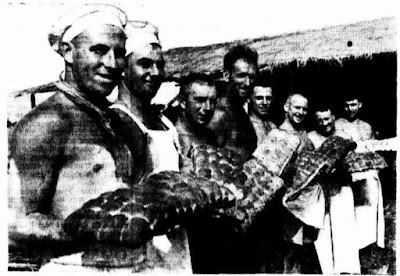The Armed Forces require people with many skills, but I have just found out that the Army had Field Bakeries, and required bakers. I have never really thought about Military food provisioning, but clearly there was a raft of cooks, food preparers and bakers required to keep the men and women fed with 'enough food to feed an Army' as the saying goes.
The Army Field Bakery in Victoria was established in April 1943 and The Argus (1) newspaper visited the 6th Australian Field Bakery and reported on it - [the bakery] can now bake enough bread in a day for 15,000 men if required. Army records were combed for men who in civil life were bakers, and eventually enough were found to complete the unit, which comprises 40 men under Lieut C. Longhurst, a third-generation master baker of Ballarat. Twenty-nine are tradesmen and the others are men doing general duties. They work different shifts.
Also attached to the unit is one large cat, described as the best mouse catcher in the camp; but so far the smell of freshly baked bread has not reached the camp mice, and Tom is idle.
Soldiers being served with the bread are equally enthusiastic. One reason is that when bread was delivered to them from Melbourne it was 72 hours old. Now the time is usually less than 24 hours, a fact which is leading to something of a crisis in the butter situation. Because the bread is fresher the men are eating more of it, and in consequence more butter (The Argus, April 14, 1943).
The Army not only had Field Bakeries in Australia, but wherever they served overseas. There was an article in the Dandenong Journal (2), which is transcribed below, about local man, George McGrath, from Nar Nar Goon who served in the Australian Field Bakery in Palestine and then in Pacific. He was listed as George in the newspaper report, but his real name was Thomas Raymond McGrath, so I presume he was known as George, to distinguish him from his Dad, who was also called Thomas, and who was also a baker.
Nar Nar Goon Man Producing Bread For Jungle FightersWorking shifts almost around the clock, members of an Army field bakery on a Pacific island produce thousands of pounds of bread daily. A Nar Nar Goon man with this unit is Pte. George McGrath, well known in local sporting circles as a member of cricket and football teams. Before the war George worked with his father, Mr. T. S. McGrath, for two years. He enlisted in 7th Division Signals in June, 1940, and served as a linesman before transferring to the bakery in Palestine in 1942.
Interviewed recently during a few minutes break from mixing dough in the iron-roofed bakery where the temperature soared around the century mark, George spoke of his service at Moresby and Milne Bay. He remembered how his unit produced bread in ovens improvised from copra kilns and reinforced with bricks salvaged from the ruins of Samarai, former trading settlement at the entrance to Milne Bay. Now the bakery uses steam pipe ovens fired with coke and capable of handling 80 loaves, in each batch. When the unit arrived at its present location the area was covered with dense jungle which had to be cleared before tents could be erected or bread baked. For several days bakers became timber-cutters, carpenters and road builders. Within a week they had cut themselves a camp site and were producing their full-scale quota of bread for thousands of Army and R.A.A.F. men on the island (Dandenong Journal, May 16, 1945)


No comments:
Post a Comment
Note: Only a member of this blog may post a comment.